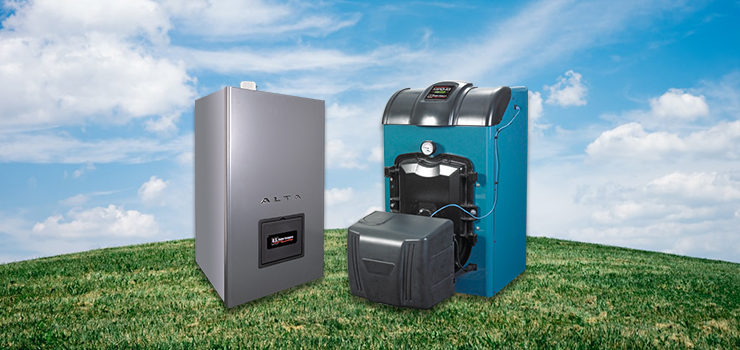By Jerry King, Technical Sales Support Specialist for U.S. Boiler Company
Just like our bodies need an adequate source of clean air to function properly, so does a boiler. Its peak performance depends on clean fresh air that is free from chemicals and pollutants.
A boiler requires oxygen to burn the fuel it uses to create the heat needed to heat the boiler water. If the air it draws in contains contaminates, it can be harmful to the boiler, keeping it from lighting or burning properly. Air is made up of 78% nitrogen, 21% oxygen, and 1% other. We will look at some of the things that affect combustion/intake air and ways to prevent issues from occurring due to contamination.
First thing first – where is the combustion air coming from?
The first thing you should consider is where the boiler’s combustion air is coming from. Whenever possible, combustion air should come from outside of the structure. In fact, an outdoor air source for combustion air is required for all of U.S. Boiler Company’s condensing products and several of their cast iron boiler models.
In most cases, an outdoor air source will ensure cleaner combustion air and adequate supply. Indoor air can have multiple contaminants from cleaning and household products.
Avoid cross contamination between intake and exhaust terminations.
The next thing you should consider is cross contamination. Cross contamination occurs when the boiler’s exhaust gasses are drawn into the boiler through the air intake pipe. Exhaust gasses not only have a reduced oxygen percentage, but they also contain carbon monoxide and caustic chemicals, such as sulfur dioxides and nitrogen dioxides. These caustic chemicals become acids when they contact water and will start to deteriorate plastic parts inside of the boiler, like wiring harnesses, venturis, and swirl plates. In cast iron boilers, these acids can also attack the cast iron heat exchangers themselves. The reduced oxygen content can also cause light-off issues and flame outs.
To prevent this, make sure there is enough distance between the intake and exhaust terminations. Never have your intake above the exhaust termination. When using a concentric or low-profile termination, always avoid the prevailing wind side of a building. When venting near an inside corner of a building, make sure the vent is closer to the inside corner and the air intake is farther from the inside corner to reduce the potential for cross contamination.
One way to check for cross contamination is with a Combustion Analyzer in the intake pipe. While the boiler is running, make sure your oxygen is around 21% and that there is no carbon monoxide.
Choosing the optimal outside location for the intake air terminal.
Always be aware of the surrounding area where you plan to locate the intake air terminal of a boiler. Sources of chemical contamination, excessive pollen, excessive dust, or the possibility of drawing in physical debris are all causes for concern. Dust and pollen can clog orifices, screens, and other small pathways in the gas train. They can also be abrasive, acting like sandpaper by wearing down soft materials over time. Larger debris can damage valves and block screens and passages that supply air and fuel mixtures. Dust, pollen, and larger debris have been known to block the burner tube on condensing boilers. Chemicals, such as chlorine and flammable materials, can cause corrosion, premature boiler failure, property damage and personal injury.
Here is a list of some sources of chemical contamination that may be located adjacent to residential boiler installations. Outside intake air locations must be selected so that they avoid the following:
- Dry cleaning/laundry areas and establishments
- Swimming pools
- Barber and beauty shops
- Metal fabrication plants
- Refrigeration repair shops
- Auto body shops
- Photo processing plants
- Plastic manufacturing plants
- Furniture refinishing areas and establishments
- New building construction
- Remodeling areas
- Garages with workshops
- Dryer vents, fume hood vents, etc.
Choosing the optimal inside location for the intake air terminal.
When it is acceptable for a hydronic application to use combustion/intake air from inside the structure, make sure you have adequate air volume to pull from as required by code. Keep all flammable liquids, materials, and other chemicals, such as laundry detergents and bleach, away from the boiler. Drawing in lint from a laundry area is also detrimental to a boiler as it may cause higher carbon monoxide numbers and clog air pathways through the equipment. Listed below are individual items that should be kept as far away from the boiler as possible.
- Spray cans containing chlorocarbons and fluorocarbons
- Chlorinated waxes and cleaners
- Chlorine-based swimming pool chemicals
- Permanent wave solutions
- Calcium chlorides used for ice melt
- Sodium chlorides used for water softening
- Refrigerant leaks
- Paint or varnish removers
- Hydrochloric acid and muriatic acid
- Cements and glues
- Antistatic fabric softeners used in clothes dryers
- Chlorine type bleaches, detergents, and cleaning solvents found in household laundry rooms
- Adhesives used to fasten building products and other similar products
- Excessive dust and dirt
Most of the sources of chemical contaminants listed above are harmful for human inhalation. Some have specific ventilation requirements or even require special breathing apparatus to work with. If you wouldn’t breathe it in, a boiler shouldn’t either. To ensure a long and trouble-free life for any boiler, make sure it gets the fresh air it needs.

